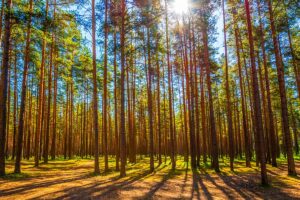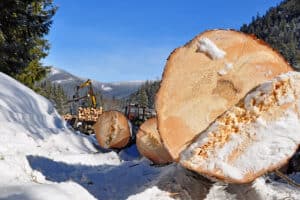The recovery of the U.S. timber market is in full swing thanks to the recent spike in single-family housing construction and remodeling across the country. Housing starts from last year eclipsed a 20% rebound threshold and this figure is predicted to approach 30% by the end of the 2013. This improvement in the housing sector has directly impacted the unemployment rate in the logging industry which is down 3.5% this year in part to the reopening of several sawmills throughout the U.S.
The re-opening of U.S. sawmills is not the only indicator that the logging industry in taking big strides forward. According to Plum Creek CEO Rick Holley:
“Mill owners are investing significant capital today in their facilities to improve efficiency and increase their future production capacity. Capital investment translates directly into a stronger customer base and increased demand for our logs in the future. This gives us great confidence in our ability to grow our earnings and cash flow from our core timber business as the recovery continues.”
Plum Creek recently invested $72 million in a 46,000 acre acquisition in Georgia and Alabama in April of this year. This transaction is a quality indicator that the southeast timber market offers great potential for timber investors of all scales.
In addition to the current domestic housing recovery, the U.S. timber market’s growth has been compounded by three non-domestic trends:
- An ongoing mountain pine beetle epidemic in British Columbia that is having a devastating impact on harvest levels;
- Increased Chinese demand for American lumber needed for a housing boom; and
- The growth of the U.S. wood pellet market that is playing a large role in assisting Europe with meeting renewable energy goals.
British Columbia has lost over 50% of their merchantable pine trees to beetles and Canada’s 25% share of the U.S. market is expected to plummet and remain below historical trends for decades. Meanwhile, the current demand for lumber in China exceeds the country’s supply of standing timber: poor timber management and illegal harvesting in the past has resulted in a shortage of supply. This demand is expected to increase by 20% in as few as five years and the impacts on the U.S. timber market will most likely be felt on a nation-wide basis. The circumstances surrounding the scenarios in China, Canada, and Europe point to major implications on the U.S timber market for many years to come and a positive long term outlook is therefore a legitimate possibility assuming the domestic housing recovery continues moving forward.
On the local level the substantial amount of rainfall over the summer months has affected South Carolina’s timber market. Several upstate South Carolina counties have already surpassed annual averages and the logging industry in this region has all but grinded to a halt due to accessibility issues. A few landowners are rolling the dice to take advantage of great prices due to lumber shortages in the mills but most timber harvests planned for the summer have been postponed until drier conditions are available. Looking ahead, the future of South Carolina’s timber industry shows great potential for a promising long term outlook. A recent study on South Carolina’s forests revealed that over the last five year many private landowners delayed the harvest of mature timber – holding out for the recovery of timber prices. This trend has created a scenario of an abundance of existing sawtimber ready for harvest. Now that timber price are recovering expect this large supply of wood to have a major impact on the market … “an additional 4-8 million tons of wood will be harvested above South Carolina’s current annual total of more than 20 million tons, an increase of 20% to 40% by 2020.” The result of this escalated harvest rate will ultimately lead to the highest levels of replanting trees since the 1980’s. Timberland owners should therefore be keeping a close eye on the current status of the farm bill as funds may be available to assist with the cost of planting new seedlings through Conservation Reserve Programs (CRP).
This content may not be used or reproduced in any manner whatsoever, in part or in whole, without written permission of LANDTHINK. Use of this content without permission is a violation of federal copyright law. The articles, posts, comments, opinions and information provided by LANDTHINK are for informational and research purposes only and DOES NOT substitute or coincide with the advice of an attorney, accountant, real estate broker or any other licensed real estate professional. LANDTHINK strongly advises visitors and readers to seek their own professional guidance and advice related to buying, investing in or selling real estate.









Good article, Rusty. Hardwood is at an all-time high and pine prices are rising. It’s a great time for investors to buy timberland.
Agreed, just need CNS to come on back as well.
This article paints an unreasonable picture of the timber markets, at least for the immediate future. Sawmills have seen an increase in run times and profitability in 2013, as prices increased from around $275/thousand board feet to over $400/thousand in April before giving some of this back. However, stumpage prices for pine sawtimber in this same period decreased from $26/ton to an average of $25.50/ton. During this same period, prices for pine pulpwood increased from around $11/ton to almost $13/ton, due to the wet weather mentioned in the article. As the US Forest Service FIA data shows, there are too many thinned stands in the SE and SC waiting to be cut, for sawtimber stumpage pricing to increase any time soon. The strong market is in pulpwood, as more of these pellet plants open and compete with the pulp/paper industry for a decreasing supply of pulpwood. I sold a stand in July for over $20/ton stumpage price and every ton was delivered to the pulp/paper mill. Current FIA data shows that for SC the 6 and 8 inch (pulpwood) is being overcut as more of these stems are being removed than we are growing. Tree planting rates have not increased and are at levels not seen since the early 60s due to the high levels of thinning. REITs and TIMOs are buying and selling lands, as mentioned, as this is their main tool in battling low timber prices and keeping returns and dividends at the levels they need. You cannot subjugate the laws of supply and demand and the timber market recovery mentioned in this article is years away.
Dean,
The logging industry unemployment rate is the lowest it’s been in 12 years and housing starts are up 20+% – you can’t tell me these aren’t signs of a timber market recovery (trends or not). As for painting an unreasonable picture of timber markets – nowhere in my article did I suggest “immediate future” spikes are in store for stumpage prices of pine sawtimber or tree planting rates. I did make the comment that sawtimber prices have recovered (meaning from basement values during the recession).
I agree that a full scale timber market recovery is a long term prospect – perhaps I should have titled the article “Current Trends and Long-Term Future Outlooks” as this was my objective (which I verbalized several times). I stand by my statement that current trends support the argument that the recovery of the U.S. timber market has begun.
-RH